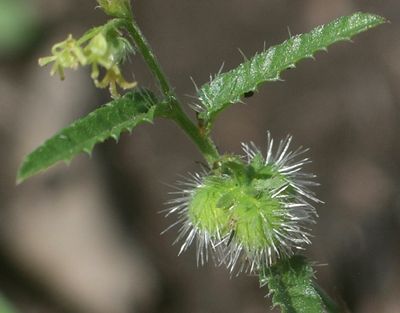
the graceful new growth of Greenbrier
 the graceful new growth of Greenbrier |
Plants in central Texas can take care of themselves. Of course, they can do that everywhere, but here it just seems more noticeable from my human perspective. One of the most easily seen, and pervasive, is a vicious vine called Cat-claw Brier. It actually has a more official, and far too benign sounding, common name: Greenbrier. However, its Latin binomial seems to give a better impression. Smilax bona-nox sounds pointy, having two Xs in it, and it implies noxious while smirking. However it is named, the plant is a vigorous and invasive native vine that grows alarmingly fast, sends roots down into solid rock, and can cover trees if left unchecked. If it is regularly cut back to the ground, after a couple of years the new shoots are so thick that they look like ropes. The robust spines on the stems can tear clothes and gouge skin. It lives all over under our yard and I've never been able to completely eradicate it. In wooded areas, it can create an impenetrable thorny barrier.
While I don't particularly appreciate Smilax, there is another very spiky plant that has some redeeming qualities. Retama, or Paloverde, (Parkinsonia aculeata) is a rather small tree with lovely lime-green bark, delicate fern-like leaves, and the occasional burst of yellow and orange flowers that rain down like confetti. There is a racetrack down near San Antonio that is named after the tree, and I actually installed a pair framing our driveway. The plants need little water, don't
 Retama flowers |
The most obvious plants with a punch are, of course, cacti and agaves. Everyone knows that you shouldn't jump in a patch of either. The former not only have large spines that can be seen and avoided, but also tiny near-invisible needles in huge numbers that secretly manage to attach at the slightest brushing contact. In no time, these work their way into the skin and can be felt but not seen. Removing them is a nightmare. Agaves are a bit more straightforward. They have lethal tip spines, which could probably be used as murder weapons. Besides that, they also possess inward facing thorns that line the sides of the leaves. These work just like the backward pointing teeth of snakes and moray eels; once the prey is caught it can only go in one direction, and it is not the desired one.
 extreme close-up of Noseburn |
Perhaps the most insidious plant is a tiny, delicate little trailing weed called Noseburn. There are several species of Tragia, but they all have the same feature: fragile stiff hairs filled with poison that lodge in the skin and cause great pain. Yes, they are similar to nettles, but are much smaller and more difficult to see and therefore avoid. When we first moved into our house, I started tackling the unforeseen task of ridding the yard of dangerous plants. The builders had pretty much removed everything above the ground except for large trees. But, within weeks, various plants came back from the tangle of roots lodged in the rocks that had been covered with the requisite inch of topsoil. I removed the sand burs. Now there's another evil plant - it masquerades as normal grass but produces stiff spiky seeds designed to be fertilized with blood. I even eradicated the poison ivy. I made an attempt on the Smilax and the Dewberry (Rubus riograndis), whose puny fruits are no compensation for the nasty prickly stems. However, in some of the weedy areas, I would suddenly feel the burning sensation that always came from nettles. But I couldn't see any plant that would account for it! It took longer than I like to admit for me to recognize the innocuous-looking leaves of Noseburn. It is still one of the easiest ways to be suddenly plunged into pain, as the horrid little plant seems to grow best in tangles of other kinds of vegetation that hide it.
So why do we soft-skinned humans even bother to venture into the wilds here in Texas? Why don't we just stick to sidewalks and roads, and never wander off the trail? Why not just stifle our curiosity and sense of adventure, and give up on exploring the fabulous ecosystem in which we live? Well, for the obvious reasons: we are just as tough as those plants, and, hopefully, a little smarter!